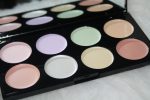Minerals in cosmetics: mica – it’s properties and effects

Recently, many girls like to use natural oils in their skin and hair care. Why are they so popular? Certainly, because they are safe and suitable for all skin types, they are easy to apply and the effects they provide are brilliant. The effectiveness of mineral cosmetics is also closely related to what they contain. One of the ingredients of such products is mica. What action and properties does this mineral provide?
What is mica?
Mika is a mineral classified as silicate; he performs in India, Russia, Canada, and Poland. The name mica means to shine, and the mineral is called a mollusk. It is used in the building, sculpting and planting industries. It is also used in the production of cosmetics with brightening and polishing effect. After applying it to the skin it is either opalescent or becomes completely transparent.
Mica in cosmetics and its properties
Before the mica is added to cosmetics, it must undergo proper laboratory tests and be thoroughly purified (it may contain harmful heavy metals). The more ground mica, the more matte and transparent it is, and the thicker it is, the more shiny it becomes. A finely ground mica gets into the cosmetics so that the application is more pleasant and the effect is more natural.
Mika is added to care and colorful cosmetics. Mineral particles reflect and scatter light, giving the complexion a radiant look. They help in the application, creating a silky and light coating for the skin. In addition, the mica prevents caking of cosmetics, and the gives a smooth finish to every makeup. Also, because it absorbs sebum poorly, it is recommended for normal and dry skin.
The use of mica in cosmetics
Mika is added to many cosmetics; most often we will meet it in mineral products. We find it, among others, in eyeshadows, powders, blushes, makeup primers, foundation, lipstick, lips and eye pencils, skin and hair balms and even toothpaste. However, in order for it to be used, it has to combine with other ingredients (because it does not adhere to the skin itself). These substances may include:
- pigments that give the cosmetic a color,
- the titanium oxides, which are natural UV filters,
- silicones forming a protective coating on the skin surface,
- silk absorbing sebum and moisture,
- waxes with oiling and glossing effect,
- other substances that have matting or whitening properties.
Is mica safe?
If the mica has been properly ground and purified, it is completely safe for the skin. It does not damage enamel and is not comedogenic and carcinogenic. However, it happens that mica of unknown origin and those in cosmetics from an unknown source can be irritating. Sometimes, instead of mica, aluminum or tiny pieces of plastic are added to cosmetics. Such surprises can be found, among others, in false makeup and care products from distant beauty markets.
How to apply mineral cosmetics with mica?
When applying mineral products with mica, one rule works best: the less, the better. It’s best to apply them with a dense, not too large brush. Brush strokes should be done gently, because mineral cosmetics can dust and run off. Use different sizes of brushes and apply them depending on the part of the face you want to cover. Mineral cosmetics with mica can be applied both dry and wet. If you do not like brushes, go ahead and use a makeup sponge.





Leave a Reply